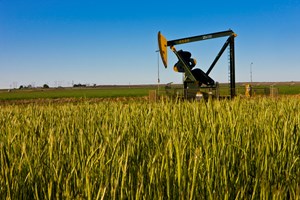Oil production plateaus in the Permian push producers to drill deeper
(Bloomberg) — With over two-thirds of the Permian’s premium land now drilled, producers are seeking more permits than ever to burrow beneath Midland and its 130,000 residents, according to BMO Capital Markets.
Analysts say the Permian could reach a production plateau within five years. Producers in the Permian’s two main zones are pumping less oil per foot drilled in each new well. Output guidance from Exxon Mobil Corp., Chevron Corp. and Devon Energy Corp. has shown that U.S. shale growth is coming in at the low end of expectations.
U.S. shale, led by the Permian, has provided 90% of global oil output growth in the past decade, according to research firm Enverus. It made the U.S. the biggest producer ahead of Saudi Arabia.
A shale slowdown means the world can no longer rely on the U.S. to be its swing oil supplier, capable of ramping up or down quickly to temper a volatile market. It complicates the Biden administration’s efforts to tame pump prices while handing more power back to OPEC as Russia’s invasion of Ukraine upends oil and gas supply.
“U.S. supply is already materially slowing down,” said Francisco Blanch, head of commodities research at Bank of America Corp. “It’s giving OPEC a lot of comfort to come in and keep prices elevated because they don’t fear US shale like they did in the past.”
The Permian Basin sprang into the public consciousness about a decade ago as new fracking techniques transformed what was thought to be a depleted oil field into some of the most desirable acreages on the planet.
Crucially, U.S. shale’s spectacular growth — adding more crude to global markets from 2012 to 2020 than the entire current production of Iraq and Iran combined — became a thorn in the eye of OPEC, which saw its market dominance threatened like never before.
But U.S. output tumbled at the start of the Covid-19 pandemic and is still about 1 million bpd below the record 13 million reached in early 2020. Next year, growth is likely to be around 560,000 bpd, according to Enverus. That’s despite crude prices averaging more than $90 a barrel this year, far above what producers need to break even.
Skyrocketing costs for labor and equipment, as well as pressure to return more cash to shareholders, are partly to blame for drillers’ restraint. Rising interest rates likely herald the end of cheap money for shale producers looking to finance even modest growth plans.
Rock is yielding less oil
Wells drilled this year produced between 8% and 13% less oil per lateral foot than a year earlier, according to BloombergNEF, the first major reversal after a decade of productivity gains. Pioneer Natural Resources Co., one of the biggest Permian operators, recently overhauled its drilling plan after executives were “not satisfied” with its well performance this year. Laredo Petroleum Inc. said some of its production was hurt by interference from other wells nearby.
A higher proportion of drilling is now done by private companies, which aren’t beholden to shareholder pressure to boost buybacks and dividends. But that’s contributing to lower productivity, according to Phillip Jungwirth, an analyst at BMO Capital Markets.
Private producers tend to have less-desirable acreage, he said. Some public and private companies are using a method known as multi-zone development, which means they’re drilling several layers of shale at once to improve efficiency. In doing they’re also tapping their less-productive rock.
BMO estimates that most of the top-tier land has already been developed in the Permian and in the Bakken of North Dakota, the top-producing shale regions. That leaves explorers with a lower inventory of the most valuable yet-to-be-drilled sites.
“We’re going to run out of inventory in the next four to six years,” said James West, an analyst at Evercore ISI. “We probably saw it earlier in other shales, which is why we left those other shales and moved so much activity into the Permian. It’s now rearing its ugly head in the Permian.”
“The Saudis and OPEC have waited this out,” said John Hess, chief executive officer at Hess Corp., which drills in the Bakken. “Now, really OPEC is back in the driver’s seat.”



